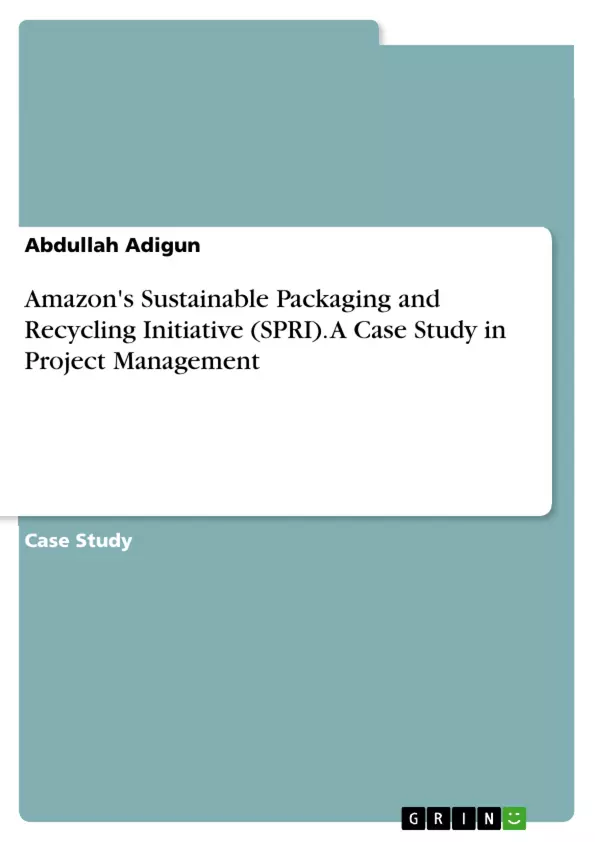This case study explores Amazon's Sustainable Packaging and Recycling Initiative (SPRI) through the lens of project management methodologies and organizational change. The study begins with an overview of Amazon's organizational profile and a summary of the SPRI project. It then delves into the need for organizational change and discusses the importance of implementing change management models, particularly Lewin’s Change Management Model. The application of this model is examined alongside the formulation of SMART targets and the anticipated benefits of change implementation.
The study further categorizes the SPRI project within different project types and execution models, emphasizing the selection of appropriate project management methodologies and standards. It outlines the phases of project management and addresses the integration of new technologies. The project proposal and planning phase detail the executive summary, project background, objectives, deliverables, resources, budget, and risk management strategies.
Key aspects such as the role of the project manager, leadership requirements, administrative functions, ethical considerations, and relationship management are explored in detail. The study also examines strategies for managing risk, uncertainty, and ambiguity throughout the project lifecycle. Project closure and evaluation processes are discussed, focusing on documentation, knowledge transfer, evaluation of project objectives, stakeholder feedback, and the use of the Balanced Scorecard framework for performance measurement.
Throughout the study, various analytical tools including PESTEL, SWOT, and STC analyses are employed to provide a comprehensive understanding of Amazon's SPRI initiative within the broader context of sustainable business practices and environmental stewardship.
Inhaltsverzeichnis (Table of Contents)
- TASK 1: OVERVIEW
- 1.0 Amazon Organisational Profile
- 1.1 Project Summary
- TASK 2: PROJECTS IN THE ORGANISATIONAL CONTEXT
- 2.0 Need for Organisational Change
- 2.1 Importance of Change
- 2.2 Explanation of the Change Management Model
- 2.3 Application of Lewin's Change Management Model
- 2.4 Benefits of Implementing the Change
- 2.5 Conclusion
- TASK 3: PROJECT TYPES AND EXECUTION MODELS
- 3.0 Project Types and Execution Models
- 3.1 Project Types
- 3.2 SPRI Project Categorisation
- 3.3 Choosing the Execution Model
- 3.3.1 Project Management Methodologies
- 3.3.2 Standards
- 3.4 Application of the Five Phases of Project Management
- 3.5 New Technology Introduction
- 3.6 Conclusion
- TASK 4: THE PROJECT PROPOSAL AND PLANNING PROJECT EXECUTION
- 4.0 Executive Summary
- 4.1 Background
- 4.1.1 History
- 4.1.2 Requirements
- 4.1.3 Business Problem
- 4.1.4 Solution
- 4.2 Proposal
- 4.2.1 Vision And Goals
- 4.2.2 Deliverables
- 4.2.3 Timeframe
- 4.2.4 Resources
- 4.2.5 Budget
- 4.2.6 Ownership
- 4.2.7 Reporting
- 4.2.8 Risks & Issues
- 4.2.9 Implications
- 4.3 Success Criteria
- 4.3.1 Authorization
- TASK 5: THE ROLE OF THE PROJECT MANAGER
- 5.1 The Role of the Project Manager
- 5.2 Leadership
- 5.3 Administration
- 5.4 Ethics
- 5.5 Relationship Management
- 5.6 Impact of Culture
- 5.7 Conclusion
- TASK 6: RISK, UNCERTAINTY, AND AMBIGUITY
- 6.0 Risk Management
- 6.1 Risk Management Process
- 6.2 Managing Uncertainty and Ambiguity
- 6.3 Conclusion
- TASK 7: PROJECT CLOSURE AND EVALUATION
- 7.0 Closure and Evaluation
- 7.1 Project Documentation and Knowledge Transfer
- 7.2 Evaluation and Measurement of Project Objectives
- 7.3 Stakeholder Feedback and Project Review
- 7.4 Framework: Balanced Scorecard
Zielsetzung und Themenschwerpunkte (Objectives and Key Themes)
This case study aims to analyze Amazon's Sustainable Packaging and Recycling Initiative (SPRI), examining its implementation within the organizational context. It explores the project's planning, execution, and the role of the project manager. The study also delves into risk management and project closure.
- Organizational change management within a large corporation.
- Project management methodologies applied to a sustainability initiative.
- Risk assessment and mitigation strategies in project implementation.
- The role and responsibilities of the project manager.
- Project evaluation and closure processes.
Zusammenfassung der Kapitel (Chapter Summaries)
TASK 1: OVERVIEW provides an organizational profile of Amazon and a summary of the SPRI project. TASK 2: PROJECTS IN THE ORGANISATIONAL CONTEXT discusses the need for organizational change and the application of a change management model to the SPRI initiative. TASK 3: PROJECT TYPES AND EXECUTION MODELS categorizes the SPRI project and examines the chosen execution model, methodologies, and phases of project management. TASK 4: THE PROJECT PROPOSAL AND PLANNING PROJECT EXECUTION details the project proposal, including background, vision, goals, deliverables, resources, budget, and risk assessment. TASK 5: THE ROLE OF THE PROJECT MANAGER explores the responsibilities and leadership aspects of the project manager within the SPRI initiative. TASK 6: RISK, UNCERTAINTY, AND AMBIGUITY focuses on risk management strategies employed within the SPRI project.
Schlüsselwörter (Keywords)
Amazon, Sustainable Packaging and Recycling Initiative (SPRI), Project Management, Change Management, Risk Management, Sustainability, Project Planning, Project Execution, Organizational Change, Project Manager.
- Quote paper
- Abdullah Adigun (Author), 2023, Amazon's Sustainable Packaging and Recycling Initiative (SPRI). A Case Study in Project Management, Munich, GRIN Verlag, https://www.hausarbeiten.de/document/1493659


